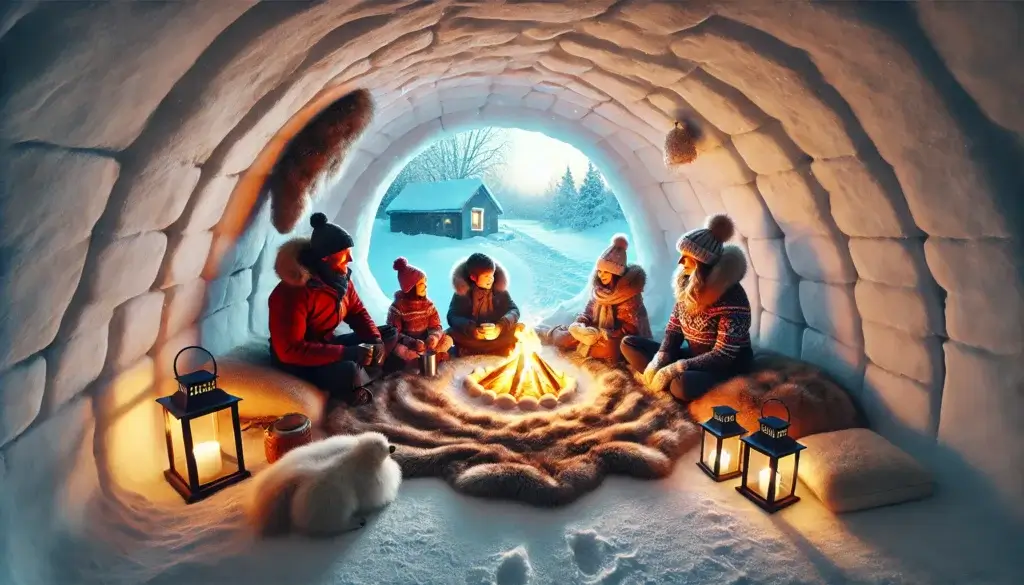Have you ever wondered how an igloo—often associated with snow and ice—can keep people warm, despite being made of frozen water? The Igloo Ice House, or snow house, is a remarkable example of human ingenuity in using available resources to create shelter in harsh climates. While igloos are commonly associated with Inuit culture, they are a type of structure used by various indigenous peoples in polar regions to survive extremely cold temperatures.
In this blog post, we will explore 6 incredible facts about how the Igloo Ice House works, explaining how its unique design and materials allow it to trap warmth and protect its inhabitants from freezing temperatures. From the principles of thermal insulation to the engineering marvels of its design, we’ll uncover how this ancient structure is far more sophisticated than it may initially seem.
1. The Science of Insulation: How Igloos Keep You Warm
One of the most astonishing facts about igloos is that, despite being made entirely of ice and snow, they are capable of keeping their inhabitants warm. This is due to the exceptional insulating properties of snow. Snow is made up of air pockets, which trap heat and prevent it from escaping. When built properly, the igloo creates a perfect combination of thermal insulation that keeps the interior much warmer than the outside environment.
Why Snow is a Natural Insulator
Snow’s unique structure allows it to act as a barrier against the cold. The air pockets in snow are a crucial factor in its ability to insulate. This design helps trap heat within the igloo, making the inside temperature several degrees warmer than the outside temperature. In fact, igloos can often maintain an interior temperature of 32°F (0°C) or higher, even when the outside temperature drops to well below freezing.
2. Igloo Design: How Shape and Architecture Matter
The shape and architecture of an igloo play a pivotal role in its ability to retain heat. Igloos are typically built in a dome shape, which is known for its energy-efficient properties. The dome shape is one of the most stable architectural forms, and it helps evenly distribute the weight of the snow. This design also minimizes the surface area that is exposed to the outside cold, further improving its insulation.
Why a Dome Shape Works
The dome shape of an igloo helps to trap heat in the center, allowing it to stay warmer inside while minimizing heat loss through the walls and ceiling. This shape is also incredibly stable, allowing the igloo to withstand heavy snowfalls without collapsing. Additionally, the compact size of an igloo helps retain heat, as there is less air space inside to cool down.

3. The Importance of Snow Quality in Igloo Construction
The quality of snow used to build an igloo is essential for its insulation properties. Builders often look for hard-packed snow that is neither too wet nor too dry. The right type of snow is crucial for creating strong blocks that fit tightly together and minimize gaps.
Building Materials: Choosing the Right Snow
The snow used for constructing an igloo needs to be firm enough to hold its shape but not so dry that it cannot be compacted. Builders typically look for granular snow, which is able to be compressed into blocks that fit together tightly, creating a strong, insulated structure. When the snow is compacted properly, it becomes less porous, improving its thermal insulation properties.
4. The Role of the Entrance: How Igloos Stay Warm Despite the Cold Air
Interestingly, the entrance of an igloo is often lower than the main living area, which helps trap warm air inside. The cold air, which is denser, naturally flows downward and out of the entrance, while the warmer air rises and stays within the igloo. This natural airflow pattern creates a passive heating system that helps to keep the interior of the igloo comfortable.
know more : Why Do Stars Twinkle
How a Low Entrance Enhances Insulation
The entrance is typically dug into the snow and designed in such a way that it’s a bit lower than the living area. This allows warm air to rise and stay inside, while cold air is naturally drawn out through the entrance. The separation of the inside and outside temperatures is key to maintaining the igloo’s internal warmth.
5. Thermal Conductivity: How the Igloo’s Material Affects Heat Retention
The thermal conductivity of materials used to build an igloo is another important factor. Ice and snow, although seemingly cold, are not great conductors of heat, meaning they don’t easily absorb or release heat. This is why the igloo remains warmer inside despite the fact that its walls are made of ice.
Insulating Properties of Ice and Snow
Ice and snow are poor conductors of heat because of the air trapped within them. This is why snow blocks used in igloo construction do not allow much heat to pass through them. The structure of the snow blocks helps to retain heat, making the igloo comfortable even in freezing temperatures. The relatively low thermal conductivity of snow also means that it won’t absorb the heat from the inside of the igloo.

6. The Efficiency of Igloos in Extreme Weather Conditions
In extremely cold environments, such as the Arctic or Antarctic, igloos provide a safe and efficient shelter. They can offer a stable, warm environment, protecting inhabitants from freezing winds, snowstorms, and other harsh weather conditions. The compact and insulating nature of an igloo makes it one of the best forms of shelter for people living in these remote, cold regions.
Why Igloos Are Ideal for Extreme Cold
The compact structure of an igloo is designed to trap as much heat as possible in the smallest space, ensuring that even in extreme cold, the inside remains comfortable. Igloos also provide a sense of security against the elements because their snow walls offer excellent protection from strong winds, while the snow-insulated roof helps keep the temperature stable. This makes them an ideal shelter for Arctic explorers and indigenous peoples living in these regions.
Conclusion: Why Igloos Are More Than Just Snow Houses
The Igloo Ice House is a remarkable example of sustainable architecture, leveraging the properties of snow and ice to create a warm, insulated shelter in some of the harshest environments on Earth. By utilizing the natural insulating qualities of snow, the dome-shaped structure, and the efficient airflow design, the igloo is a testament to human ingenuity in adapting to extreme climates.
Whether you’re an outdoor enthusiast, a student of architecture, or someone fascinated by the wonders of the natural world, understanding how igloos work offers valuable insight into the ways humans have adapted to their environment over thousands of years. These structures are not just snow houses—they are practical, energy-efficient homes that highlight the importance of using natural materials to create sustainable living conditions.